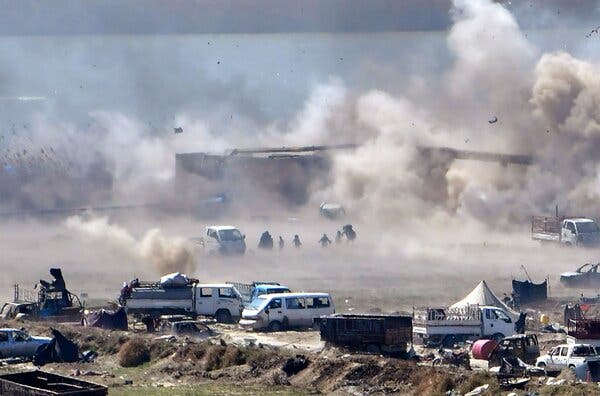
How the US hid an airstrike that killed dozens of civilians in Syria
In the last days of the battle against the Islamic State group in Syria, when members of the formerly-fierce caliphate were possessed in a dirt field next to a city called Baghuz, a US service drone circled high outflow, hunting for military targets. But it saw only a large crowd of women and children huddled against a swash bank.
Without warning, a US F-15E attack spurt barred across the drone’s high- description field of vision and dropped a 500-pound lemon on the crowd. Also a spurt dropped one-pound lemon, also another.
It was 18 March, 2019. At the US service’s busy Combined Air Operations Center at Al Udeid Air Base in Qatar, uniformed help watching the live drone footage looked on in stupefied unbelief.
“ Who dropped that?” a confused critic compartmented on a secure converse system being used by those covering the drone. Another responded, “ We just dropped on 50 women and children.”
The Baghuz strike was one of the largest mercenary casualty incidents of the war against the Islamic State, but it has noway been intimately conceded by the US service. The details, reported then for the first time, show that the death risk was nearly incontinently apparent to military officers.
A legal officer flagged the strike as a possible war crime that needed an disquisition. But at nearly every step, the service made moves that concealed the disastrous strike. The death risk was de-emphasized. Reports were delayed, sanitized and classified. US- led coalition forces bulldozed the blast point. And top leaders weren’t notified.
The defence department’s independent inspector general began an inquiry, but the report containing its findings was stalled and stripped of any citation of the strike.
“ Leadership just sounded so set on burying this,” said Gene Tate, an annotator who worked on the case for the inspector general’s office and agreed to bandy the aspects that weren’t classified.
Tate, a former Navy officer who had worked for times as a mercenary critic with the Defense Intelligence Agency and the National Counterterrorism Center before moving to the inspector general’s office, said he blamed the lack of action and was ultimately forced out of his job.
The details of the strikes were erected together by The New York Times over months from nonpublic documents and descriptions of classified reports as well as interviews with help directly involved and officers with top secret security concurrences who bandied the incident on the condition that they not be named.
The Times disquisition plant that the bombing had been called in by a classified US special operations unit, Task Force 9, which was in charge of ground operations in Syria. The task force operated in similar secretiveness that at times it didn’t inform indeed its own military mates of its conduct. In the case of the Baghuz bombing, the US Air Force command in Qatar had no idea the strike was coming.
After the strike, an terrified Air Force intelligence officer in the operations center called over an Air Force counsel in charge of determining the legitimacy of strikes. The counsel ordered the F-15E squadron and the drone crew to save all videotape and other substantiation. He went upstairs and reported the strike to his chain of command, saying it was a possible violation of the law of fortified conflict — a war crime — and regulations needed a thorough, independent disquisition.
But a thorough, independent disquisition noway happed.
This once week, after the Times transferred its findings to US Central Command, which oversaw the air war in Syria, the command conceded the strikes for the first time, saying 80 people were killed but the airstrikes were justified. It said the losers killed 16 fighters and four civilians. As for the other 60 people killed, the statement said it wasn’t clear that they were civilians, in part because women and children in the Islamic State occasionally took up arms.
The only assessment done incontinently after the strike was performed by the same ground unit that ordered the strike. It determined that the bombing was legal because it killed only a small number of civilians while targeting Islamic State fighters in an attempt to cover coalition forces. Thus, no formal war crime announcement, felonious disquisition or correctional action was warranted.
But the Air Force counsel,Lt.Col. Dean Korsak, believed he’d witnessed possible war crimes and constantly pressed his leadership and Air Force miscreant investigators to act. When they did not, he advised the defence Department’s independent inspector general. Two times after the strike, seeing no substantiation that the watchdog agency was taking action, Korsak posted the Senate Armed Services Committee.



Average Rating